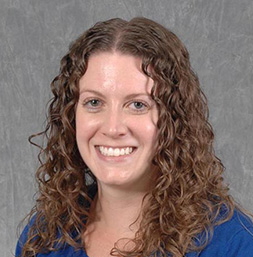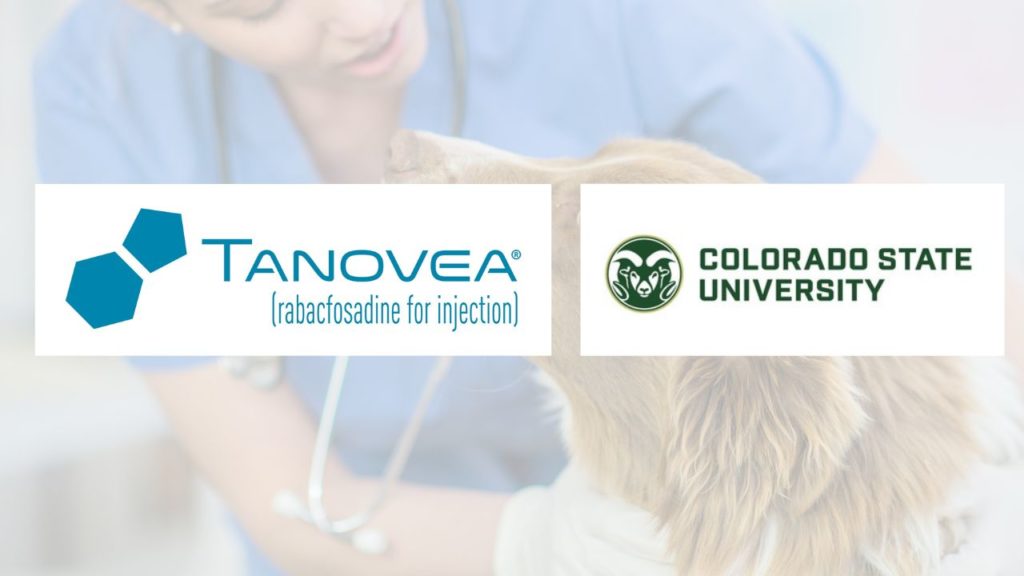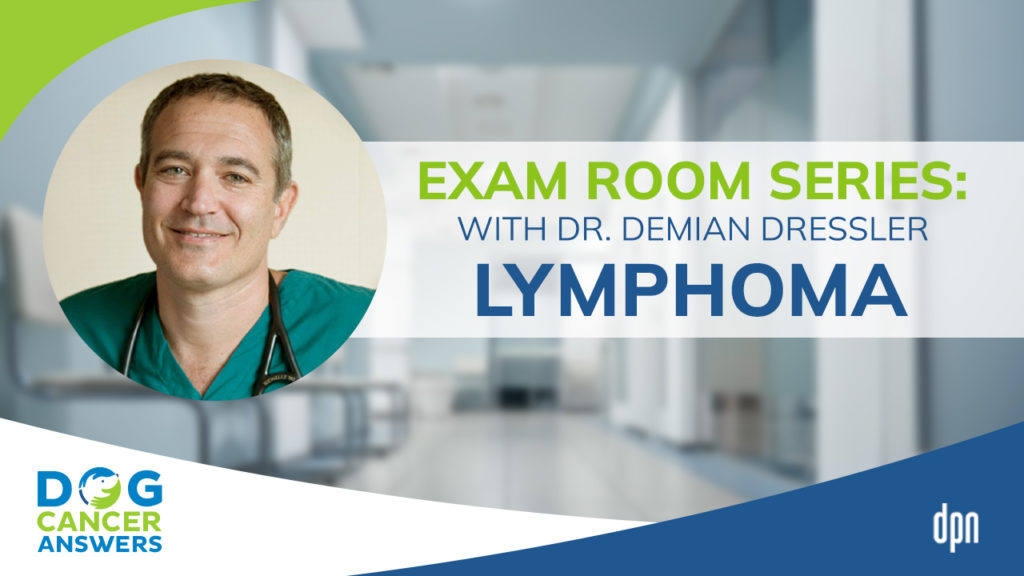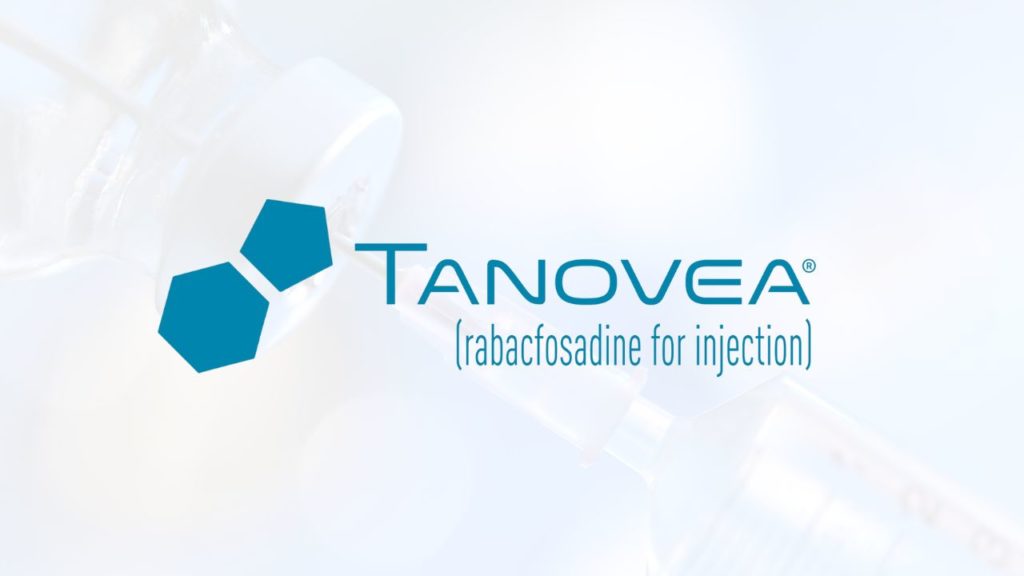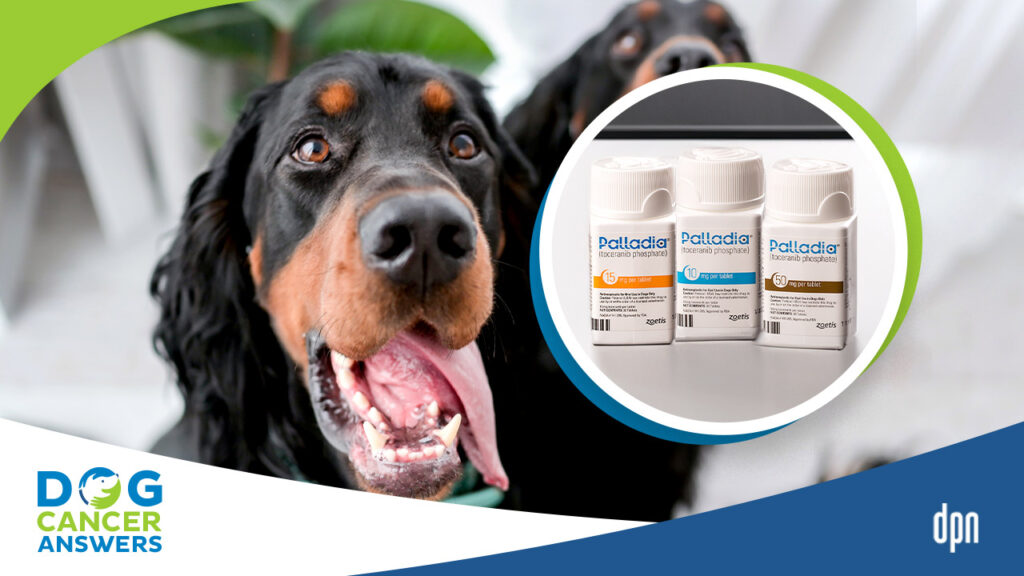EPISODE 145 | RELEASED December 13, 2021
Laverdia: A New Treatment for Lymphoma | Dr. David Bruyette, Dr. Megan Duffy, and Dr. Craig Clifford Deep Dive
Laverdia-Ca1 is a new, oral treatment for lymphoma that you can give to your dog at home. We still have more to learn, but this drug shows promise.
SHOW NOTES
Three veterinary oncologists discuss how Laverdia works and where it might fit into treatment plans for dogs with lymphoma.
Links Mentioned in Today’s Show:
Anivive Lifesciences – Laverdia
Anivive Lifesciences – Clinical Trials
How Laverdia Works video
Conditional Approval Explained: A Resource for Veterinarians
[00:00:00] >> James Jacobson: Today’s show is brought to you by the bestselling book, The Dog Cancer Survival Guide: Full Spectrum Treatments to Optimize Your Dog’s Life Quality and Longevity. It’s available everywhere books are sold in both paperback and digital editions and on the publisher’s website at DogCancerBook.com. Use coupon code PODCAST on that website to get 10% off The Dog Cancer Survival Guide today.
[00:00:30] >> Dr. David Bruyette: We’re not looking to replace CHOP, our concern and our desire to bring this drug forward was, unfortunately, CHOP doesn’t cure the dogs.
So you get the longest remission times – on average about 12 months – but the vast majority of dogs with lymphoma die from lymphoma. So what we wanted to do was, well, let’s say that you have the resources and you’re interested in standard of care chemo. Well, what do you do when it fails? We also wanted to have something available for the 500,000 dogs that just weren’t getting anything because the owners just couldn’t manage to go down that route. And so that’s really where Laverdia stands out.
[00:01:06] >> Announcer: Welcome to Dog Cancer Answers, where we help you help your dog with cancer. Here’s your host, James Jacobson.
[00:01:14] >> James Jacobson: Hello friend. Today’s episode is on the longer side, but it is packed with information about an exciting new treatment on the scene to battle lymphoma in dogs.
The drug in question is verdinexor, better known by the trade name Laverdia-CA1. This oral tablet can be given at home twice a week, and it is designed to be a more convenient and more cost effective option for dog lovers who can’t afford the gold standard of the CHOP chemotherapy protocol. Laverdia is currently conditionally approved by the FDA.
There are more studies in the pipeline as the drug maker is seeking full FDA approval. To learn more about this drug, we have not one, not two, but three veterinarians joining us today. First up, we’ll be speaking with Dr. David Bruyette, who is also the chief medical officer for Anivive Lifesciences. That is the company that developed Laverdia.
Dr. Bruyette is a boarded internist, and we’ll talk to him through the nitty gritty about how Laverdia works, and what exactly conditionally approved really means. After we hear from Dr. Bruyette we will also turn to two oncologists, Dr. Megan Duffy and Dr. Craig Clifford. We will speak candidly with those oncologists to find out how Laverdia has been doing in the field at their veterinary oncology practices. As a bonus, all three veterinarians will give their insight into lymphoma in general. So with that roadmap to this episode, let’s introduce our first guest. As well as developing cancer treatments, Dr. David Bruyette has a long and varied career in veterinary medicine. He’s worked in both specialty and emergency practices and has even taught at Kansas State University.
Dr. David Bruyette thank you so much for being with us today.
[00:03:15] >> Dr. David Bruyette: Oh, thank you for inviting me.
[00:03:17] >> James Jacobson: So you are the guy behind Laverdia that so many people with lymphoma have been talking about.
[00:03:24] >> Dr. David Bruyette: I’m the chief medical officer for Anivive Lifesciences, and certainly, uh, we’re excited to be able to bring Laverdia forward. The drug was originally developed on the human side, and then we repurposed it really for veterinary use.
[00:03:39] >> James Jacobson: We’ll get into that later ’cause I think that’s kind of a fascinating process, but for people who are, like, new to this and have a dog that has been diagnosed with lymphoma, what is so special about Laverdia?
[00:03:55] >> Dr. David Bruyette: Well, I think from a pet owner and a veterinary perspective, I think the things that make Laverdia unique is that right now we know that there’s, you know, 700,000 plus dogs that are being diagnosed with lymphoma every year.
[00:04:08] >> James Jacobson: Is that in the US or is that worldwide?
[00:04:10] >> Dr. David Bruyette: That’s just, that’s just US, US figures.
It’s probably double that if you take in the rest of the, the rest of the world. The biggest problem that we see from a veterinary perspective is that 80% of those dogs never really get treated. Um, that owners decide not to go down sort of the traditional chemotherapy route. And there’s a bunch of reasons why that happens, you know, they’re, they’re concerned about side effects, they’re concerned about the cost of injectable chemo, they’re concerned about having to go back and forth to the vet all the time. So when we set about the task of finding a new drug for lymphoma, those were the types of things we were super interested in. That we wanted to bring a novel drug, with a novel mechanism of action, with the side effect profile that we thought that pet owners and veterinarians would be comfortable with, and something that could be given at home at a price point where we don’t want owners to have to make treatment decisions solely based on cost.
And so there’s lots of factors that go into why, you know, a pet owner and a family decide to treat or not treat, but we were trying to remove money from that equation.
[00:05:17] >> James Jacobson: And how have you removed money from the equation? Because it’s just a lot less expensive than traditional chemo?
[00:05:22] >> Dr. David Bruyette: Well, yeah, part of the reason is that the drug itself is what’s described as a small molecule.
So cancer drugs typically get defined as either a small molecule, some chemical-based drug, or a biologic, like an antibody. And small molecules, especially if they’re developed to be oral, are a lot less expensive than what you have to go through to develop injectable chemotherapy drugs.
[00:05:46] >> James Jacobson: And this goes back to sort of the whole economics of pharmaceuticals, which is how much money do you spend to develop the first pill?
[00:05:53] >> Dr. David Bruyette: Right.
[00:05:53] >> James Jacobson: Yeah every other pill after that’s, you know, a few cents, but the first pill, and then you have to amortize that.
[00:05:58] >> Dr. David Bruyette: Exactly.
[00:05:58] >> James Jacobson: So it’s just less expensive to develop that first pill, that Laverdia.
[00:06:02] >> Dr. David Bruyette: Correct.
[00:06:02] >> James Jacobson: Well, I mean, let’s talk about that. So it, it started, you said in the human space?
[00:06:06] >> Dr. David Bruyette: Right. There was, uh, our partner’s, a company called Karyopharm in Boston was developing these class of drugs, it’s a novel mechanism of action called SINE Inhibition.
[00:06:16] >> James Jacobson: SINE as in.
[00:06:17] >> Dr. David Bruyette: S I N E.
[00:06:19] >> James Jacobson: Okay. As in a sine wave?
[00:06:21] >> Dr. David Bruyette: Yeah, exactly. It stands for Selective Inhibition of Nuclear Export.
[00:06:26] >> James Jacobson: Ah, okay. Acronym.
[00:06:27] >> Dr. David Bruyette: And basically it keeps the cells, um, causes them to retain certain proteins that cause the cell to die. Whereas cancer cells pump those proteins out of the cell so that they can become immortal.
So they were developing drugs that were SINE inhibitors. They developed two drugs, and based on how one drug was better absorbed in people, they developed that for human use, which left the other compound open for veterinary application.
[00:06:54] >> James Jacobson: Interesting. So they developed two, and then what is the sister drug that is actually used in humans?
[00:06:59] >> Dr. David Bruyette: Yeah, the sister drug is called selinexor. Our drug is verdinexor.
[00:07:03] >> James Jacobson: Okay.
[00:07:04] >> Dr. David Bruyette: And it was approved a couple of years ago to treat multiple myeloma and lymphoma in humans.
[00:07:10] >> James Jacobson: Got it. Okay. And so all of these are, are in a class of action, I guess, that we would call targeted therapy.
[00:07:18] >> Dr. David Bruyette: Correct. Correct.
[00:07:19] >> James Jacobson: So explain that.
[00:07:20] >> Dr. David Bruyette: Well, traditional chemotherapy drugs, like the drugs that are commonly used in CHOP, the most common lymphoma protocol, they’re called non-selective cytotoxics, which means they just kill any cell that’s growing fast, independent of whether it’s a normal cell or cancer cell.
That’s why a lot of the side effects of chemotherapy in people and animals are almost always the same. Vomiting, diarrhea, hair loss, bone marrow suppression. That’s because your hair cells, the cells in your intestine, and the cells in your bone marrow grow fast normally. And so the chemo drugs can’t tell that apart from a rapidly dividing cancer cell. Targeted treatments are designed to address a certain mutation that’s present within a cancer cell but not present in a human cell, human normal cell, so that when you give it, most of the drug is going to be delivered just to the cancer cell and it will relatively spare the healthy tissue.
[00:08:18] >> James Jacobson: Okay. So let’s talk specifically about the mechanisms of Laverdia and why it really is focused on this one type of cancer, which is-
[00:08:26] >> Dr. David Bruyette: right.
[00:08:26] >> James Jacobson: ‘Cause you say, you know, 700,000 cases in the US alone, lymphoma.
[00:08:31] >> Dr. David Bruyette: Well, what happened was when the folks at Karyopharm were would looking at, well, what cancers have this mechanism behind it? Where do you see these proteins, these cancer reducing proteins being removed from the cell? They screened lots of cancers. Solid cancers, blood cancers, and they found that the greatest activity seemed to be against these bloodborne cancers, lymphomas and myelomas.
And then Dr. Cheryl London, who’s a veterinary oncologist researcher who was at Ohio State and now at Tufts, did the same thing and she said, well, let’s look at dog cancers and see what dog cancers would have that same mechanism. And she found pretty much the same thing, that there was a lot of activity against lymphomas, uh, in dogs, and that this would be a good target to go after as a, as a novel therapeutic.
[00:09:19] >> James Jacobson: So, you know, one of the things that we’ve said for years is that lymphoma is one cancer that clearly has a solution. And for so many years, that has been the CHOP protocol and-
[00:09:32] >> Dr. David Bruyette: right.
[00:09:32] >> James Jacobson: Well, because you are a vet, I’m going to make you break down what the word CHOP is. That’s one of these things I got.
[00:09:37] >> Dr. David Bruyette: Yeah.
[00:09:38] >> James Jacobson: It’s a, it’s an an acronym as well.
[00:09:40] >> Dr. David Bruyette: It is. Each of the letters, C H O P stands for the first letter in the drug that it represents. So CHOP. C is Cytoxan. H is Hydroxydaunorubicin or Doxorubicin. O is Oncovin, which is Vincristine. And the P is Prednisone.
[00:09:58] >> James Jacobson: Okay. So congratulations. You’re going to be my partner in Trivial Pursuit uh vet edition. But it’s a common thing, well, it’s called the Wisconsin CHOP Protocol because it was developed at the University of Wisconsin.
[00:10:08] >> Dr. David Bruyette: Yup.
[00:10:08] >> James Jacobson: It’s been used for many, many years. Laverdia is an alternative, obviously the CHOP protocol is not just an orally administered chemo that is done at home, but it’s more complicated. This is a pill that you can give at home.
[00:10:22] >> Dr. David Bruyette: Right.
[00:10:23] >> James Jacobson: When would you use Laverdia versus CHOP?
[00:10:26] >> Dr. David Bruyette: Yeah, it’s a great question. And really when we were looking to develop the drug and were doing the studies on Laverdia and lymphoma, it’s not a replacement for CHOP.
[00:10:35] >> James Jacobson: Okay.
[00:10:36] >> Dr. David Bruyette: If you look at standard of care, treatment of lymphoma, multiple agent cytotoxic agents result in the longest remission times and the highest remission rates.
And so we’re not looking to replace CHOP, our concern and our desire to bring this drug forward was, unfortunately CHOP doesn’t cure the dogs. So you get the longest remission times – on average about 12 months – but the vast majority of dogs with lymphoma die from lymphoma. So what we wanted to do was, well, let’s say that you have the resources and you’re interested in standard of care chemo.
Well, what do you do when it fails eventually? There is, you could go back on CHOP, there’s other cytotoxics that you could use. A lot of owners, the dogs feel, still feel good, so they don’t want to just stop treatment. So they’re looking for something to do in that setting. And we also wanted to have something available for the 500,000 dogs that just weren’t getting anything because the owners just couldn’t manage to go down that route.
And so that’s really where Laverdia stands out. It can be used in dogs where owners don’t want to do CHOP, so they only take Laverdia and and possibly a low dose of Prednisone. In dogs that failed CHOP, then they’re using it in a relapse setting to buy their dog some more time. And now in the COVID era, what we’ve been seeing is that a lot of dogs who get diagnosed with lymphoma, it’s hard to get in to an oncologist.
Um, you know, there’s a delay. So oncologists are looking at it and going, well, I would rather that a dog get on Laverdia rather than high doses of steroids, because we know steroids adversely affect response to subsequent chemo. And that’s not the issue with Laverdia because it doesn’t induce resistance to chemotherapy.
[00:12:18] >> James Jacobson: Okay. Let’s break down some of those things. You talked about Pred, which is a steroid.
[00:12:22] >> Dr. David Bruyette: Yup.
[00:12:23] >> James Jacobson: And it’s commonly used.
[00:12:24] >> Dr. David Bruyette: Yes.
[00:12:24] >> James Jacobson: And Laverdia and Pred together are ok.
[00:12:28] >> Dr. David Bruyette: Yeah. So let’s just back up and say, if your dog gets diagnosed with lymphoma and nothing’s done, you opt not to do any form of treatment, we know that average survival time is about 21 days.
It’s very short. If you use prednisone, typically what vets have done is used relatively high doses of prednisone. So one to two milligrams per kilogram, per day. The downside of high-dose steroids is that they’re associated with side effects. They make the dog drink a lot, pee a lot, start to have accidents in the house, they pant, they’re crazy hungry, and they can be, have some behavioral changes associated with it. But if you look at survival times, if all you get is high dose pred, it’s still somewhere between 25 and 50 days of average survival. Because the cancer cells become really resistant to prednisone pretty fast.
So what we’ve been seeing is that we’re not telling people not to use steroids, we think there’s a place for steroids, for sure, but what we’re looking at is if you use low doses, lower doses of steroids, such that you’re not running into side effects, and you use Laverdia together, you’re getting increased survival over pred alone of about 50%.
And about a third of the dogs have an opportunity to go out to 9 and 10 months. So, well, the way that we have positioned it with vets and with owners is that it doesn’t cost a whole lot more per day to go onto Laverdia and you have the potential for extending it out at least 50% longer than pred, but you also have this opportunity to go out significantly longer.
[00:13:58] >> James Jacobson: Okay. So CHOP is still considered the standard of care.
[00:14:02] >> Dr. David Bruyette: Yes.
[00:14:02] >> James Jacobson: Let’s break down that term because I think for dog owners who are just learning some of this language, it’s one of these, well standard of care or what, what is that?
[00:14:10] >> Dr. David Bruyette: Yeah, so standard of care, basically is, with respect to lymphoma, the CHOP protocol is the preferred treatment, the treatment for which there’s the most, you know, data to support that, you do CHOP, this is what you can expect. You know, these types of side effects, this type of response rate, and this duration of remission. But all of the drugs that are in CHOP, none of those drugs are approved for use in dogs. And so one of the issues that we’re trying to do is to bring more approved drugs to the market because when the drug’s approved, there’s a lot more data specific to that drug in terms of safety, efficacy, and then you get support from the folks that are manufacturing the drug if you have questions or issues. Right now, if you’re using a human cancer drug off label and something goes wrong, it’s like, yeah, you don’t have anywhere to go. You know, there’s no recourse other than to default back to the veterinarian.
[00:15:02] >> James Jacobson: Okay. So, is your aspiration, your hope, if everything were to be, you know this is a conditional drug right now, but-
[00:15:08] >> Dr. David Bruyette: Right.
[00:15:08] >> James Jacobson: And we’ll talk about that –
[00:15:09] >> Dr. David Bruyette: Yup.
[00:15:10] >> James Jacobson: Is your hope that maybe this will be considered the new standard of care.
[00:15:15] >> Dr. David Bruyette: Well, the way that we were, are working with additional studies that we’re doing is to have it viewed as it can be incorporated into standard of care. Whether it’s given upfront, whether it’s given at the end of CHOP, so let’s say the dog goes into remission, is it something that could be used in a maintenance type setting to try and keep it from coming back? And in dogs that relapse. So, yeah, I think – we’re also doing other studies to see, can you put it into CHOP? You know, a verdinexor CHOP protocol.
[00:15:44] >> James Jacobson: Okay.
[00:15:45] >> Dr. David Bruyette: So if you look at humans, what’s happened in human oncology, CHOP was the standard of care forever, you know, 30, 40 years. And then Rituximab the monoclonal antibody came out. And now it’s our CHOP. So it’s Rituximab CHOP is the standard of care in people.
[00:15:59] >> James Jacobson: And obviously monoclonal antibodies have been in the news these days with COVID, so more and more people are-
[00:16:05] >> Dr. David Bruyette: Yeah, exactly. You know, it makes sense from a, you know, a mechanism, it makes sense to get monoclonals involved in this sort of setting.
I think the ultimate dream for lymphoma, though, if you look at it from a big picture is, in humans, you can cure people, you know, with these diseases. In dogs and cats, we don’t really have that technology yet because we can’t, and don’t really want to push a dog or a cat that hard with CHOP because while we could potentially cure some, we’re going to potentially lose some. Because we don’t get to go in and rescue them with bone marrow transplants and stem cell transplants and things like that.
So we’re always going to have to be cognizant of how aggressive can we be trying to push out survival without doing something that adversely affects the pet’s quality of life.
[00:16:49] >> James Jacobson: This gets to that famous three letters, MTD, maximum tolerated dose.
[00:16:56] >> Dr. David Bruyette: Right.
[00:16:56] >> James Jacobson: And if you’d explain that.
[00:16:57] >> Dr. David Bruyette: Sure. And so in the world of oncology, we, we look at that. We look at Maximum Tolerated Dose and we look at Minimal Effective Dose. So one of the things you have to figure out with your drug is well, what’s the smallest amount of drug that will have an effect on that cancer. And conversely, how high can you go with that dose before you start to see adverse events that you don’t want to have.
And so then your therapeutic dose is in that window between minimal dose and the most that an animal will be able to tolerate, and an owner and a vet would be willing to tolerate.
[00:17:30] >> James Jacobson: Let’s talk dollars and cents for a moment. You said this is a lot less expensive. So an average CHOP protocol costs what? An average Laverdia only, or maybe a Laverdia with Pred costs what?
[00:17:41] >> Dr. David Bruyette: Yeah. So CHOP prices kind of depend on what part of the country you live in. Um, but somewhere, a standard Wisconsin protocol, CHOP price would be somewhere between $6,000 and $10,000 to go through the cycle. With Laverdia we’re looking at somewhere, to the pet owner, the cost to a pet owner, around $200 a month.
So there’s a significant cost savings, not only in drug costs, but there’s fewer office visits, you don’t have to do a lot of routine blood monitoring, because the drug itself doesn’t cause hematologic side effects that you have to monitor. So there’s savings in, in that regard as well.
[00:18:18] >> James Jacobson: And then have you done longitudinal, I mean, I know it’s still new, but, and you guys again, under conditional approval, so we’ll talk about that, but-
[00:18:24] >> Dr. David Bruyette: Sure.
[00:18:25] >> James Jacobson: Have you done longitudinal studies? Do you know what, you know, the average or median life expectancy is on one protocol versus the other?
[00:18:34] >> Dr. David Bruyette: Yeah. So with, with multi-agent drugs, like CHOP, you know, the median survival time is around 12 months. The fewer drugs you’re giving, the shorter that window becomes. So when we’re looking at things like Laverdia, whether we’re doing it upfront, where that’s the only drug they’re going to get, or we’re looking at the tail end, that they’ve gone through CHOP and failed, and now they’re going on Laverdia, median time on drugs is going to be about two and a half to three months.
But again, a third of them – and this is one of our areas of interest is why do those third do so well – but a third of them can stay on the drug for, you know, up to nine months.
[00:19:11] >> James Jacobson: Wow. So, but median is still just two or three?
[00:19:15] >> Dr. David Bruyette: Two to three, right.
[00:19:16] >> James Jacobson: Okay. So median is this number that we all learned in math class that we kind of confused with averages.
[00:19:22] >> Dr. David Bruyette: Correct.
[00:19:22] >> James Jacobson: So again, if you would break that down for everyone.
[00:19:25] >> Dr. David Bruyette: Yeah. So median, you know, average is you add everything up, divide by the number of patients and you get a number. Median’s the most common number that occurs in the distribution. So it helps you deal with the fact that you can have outliers on either side.
[00:19:38] >> James Jacobson: Got it. So sometimes when you hear these great success, they are one of those outliers. And conversely, when sometimes someone said it didn’t work for me, they’re on the other side of that. So you’ll line up all the numbers and the one that is in the middle is the, is the median.
[00:19:52] >> Dr. David Bruyette: Exactly.
[00:19:52] >> James Jacobson: Sometimes very different when it comes to cancer than, than the average.
[00:19:55] >> Dr. David Bruyette: Yes, exactly.
[00:19:57] >> James Jacobson: So talk about the action of agent. You have a pretty dramatic video on your website, which, uh, we will put a link to, that is almost Sci-Fi and it’s like spectacular sound effects, but what is the method of agent that Laverdia uses?
[00:20:13] >> Dr. David Bruyette: In terms of its mechanism of action?
[00:20:14] >> James Jacobson: Mechanism of action, yeah.
[00:20:16] >> Dr. David Bruyette: So the mechanism of action is, that basically what the drug does is it binds to a protein called the XPO1 or Export One. And XPO1’s normal function is to bind tumor suppressor proteins, and take them from the nucleus of the cell, out into the cytoplasm.
And when they’re out in the cytoplasm, they can’t interact with the DNA. And so if those tumor suppressor proteins are not in the nucleus, the cell doesn’t know it should stop dividing. So it just keeps growing and growing and dividing and dividing. What happens with verdinexor is that when Laverdia binds to XPO1 it cannot bind to tumor suppressor proteins, so they’re retained in the cell and it causes that cell to undergo what’s called programmed cell death. And that cell basically commits suicide.
[00:21:03] >> James Jacobson: And that’s apoptosis.
[00:21:04] >> Dr. David Bruyette: That’s apoptosis.
[00:21:05] >> James Jacobson: Which is a term that we talk about a lot with, uh, on this show. What are the side effects of Laverdia?
[00:21:11] >> Dr. David Bruyette: So the, the main side effects that we’ve seen in cancer dogs, and this is, it’s hard because cancer dogs typically are sick dogs, but the main side effects that we see are GI. So decreased appetite, then the next two would be GI upset, such as vomiting and diarrhea. Now in the studies that were done, the vast majority of the side effects that occurred were described as, uh, you guys are probably familiar with the VCOG criteria, the veterinary cancer group which does scoring systems. So most of the side effects were mild, grade one or two, which meant they were, could be managed at home and managed with symptomatic care. They didn’t require hospitalization. So the, the main side effects are going to be gastrointestinal.
Some of those can be mitigated by anti-nausea medications on the day, ’cause they only take the drug twice a week.
[00:22:02] >> James Jacobson: Two times a week.
[00:22:03] >> Dr. David Bruyette: Two times a week. Yeah. They could take an anti-nausea med the day of, and then if they start to have loose stool, we usually modify that with diet and probiotics.
[00:22:12] >> James Jacobson: Okay. Any other side effects?
[00:22:14] >> Dr. David Bruyette: Yeah, those are the most common ones. It doesn’t cause liver or renal side effects, kidney side effects, and it doesn’t affect the bone marrow. So.
[00:22:22] >> James Jacobson: And it is of course, a chemotherapy agent. So you, as you handle it, have to treat it very carefully.
[00:22:28] >> Dr. David Bruyette: Right. It is a, it is a coated tablet, so you don’t have direct contact with the drug, but we do recommend that whoever is administering the drug wear chemo resistant gloves. And so we provide those, veterinary clinics have those types of gloves. Hopefully when you’re picking up the dog’s poop, you’re wearing gloves anyway, but you should be wearing gloves when you’re doing that.
[00:22:46] >> James Jacobson: Okay. And like pregnant people?
[00:22:48] >> Dr. David Bruyette: Yeah, for sure. They should not be handling any type of chemotherapy drugs. So it’s very similar to what the recommendations would be if a vet was prescribing any other oral chemotherapy drug.
[00:23:00] >> James Jacobson: Okay. So conditional approval by the FDA. What does that mean?
[00:23:06] >> Dr. David Bruyette: So conditional approval is a path that the FDA has in place to get drugs to market for diseases that there are no good treatments for that are, that are out there.
The only real difference between a conditionally approved drug and a fully approved drug is the data that’s there to support the efficacy component of the claim. So a conditionally approved drug has to adhere to the same safety data, so it would be the same, our safety data would support full approval.
Our manufacturing would be in keeping with the full approval. The differences is that our efficacy is based on what’s called "reasonable expectation" of efficacy. The data that was generated at Ohio State and at Tufts, um, was used as the basis for the efficacy approval, and then we’re now getting ready to do a larger, what’s called a pivotal field study, which will be designed to get the full approval.
[00:24:00] >> James Jacobson: Got it. And so the safety is the same as if it were FDA approved. Okay.
[00:24:05] >> Dr. David Bruyette: Exactly correct. Yep.
[00:24:06] >> James Jacobson: So what’s the next step in the approval process? When do you see that moving forward?
[00:24:10] >> Dr. David Bruyette: So that study will begin early next year. We’ll be enrolling dogs into that study, very similar study design to what was done previously. B and T cell lymphomas, naive and relapse lymphomas. Then once all those dogs are enrolled, go through treatment, the data is accumulated, that all goes back into the FDA, and then it goes through the approval process there in order to reach your full approval.
[00:24:34] >> James Jacobson: So if one of our listeners would like to be considered for those trials, is there a way of, of enrolling or nominating yourself?
[00:24:43] >> Dr. David Bruyette: Well with lymphoma right now, it’d be tough because you wouldn’t want to wait to get into a study that’s not going to start till next year. So.
[00:24:49] >> James Jacobson: People still listen to this podcast well into the future.
[00:24:51] >> Dr. David Bruyette: Of course they do. Of course they do. If they go to Anivive.com to our website, there is an area devoted to clinical trials and they can register on the site.
[00:25:00] >> James Jacobson: Okay.
[00:25:00] >> Dr. David Bruyette: And then we’ll keep them informed about any studies that we’re doing.
[00:25:03] >> James Jacobson: Okay. We’ll put links to that in the show notes.
[00:25:05] >> Dr. David Bruyette: Okay.
[00:25:05] >> James Jacobson: Now is this a drug that can be, is it only used by a veterinary oncologist or can a general practice vet use it as well?
[00:25:14] >> Dr. David Bruyette: No, another good question. So it is designed to be used by both groups. You know, when we launched the drug, we first, uh, went out and educated oncologists and made it available to oncologists first, ’cause we know that they are the folks that the general practice vets are going to call and say, Hey, what do you think about this drug?
[00:25:29] >> James Jacobson: Okay. The key opinion leaders.
[00:25:31] >> Dr. David Bruyette: Key opinion leaders. Yeah. So any veterinarian can prescribe the drug.
[00:25:35] >> James Jacobson: Okay.
[00:25:35] >> Dr. David Bruyette: And I should, I should mention this because they didn’t mention it before, but the other thing with conditionally approved drugs is that you can only use it for the licensed indication. So Laverdia in the conditionally improved state can only be used for the treatment of lymphoma in dogs.
So it cannot be used off label like other approved drugs are used off label all the time. It cannot be used to treat other cancers unless we’re doing it as part of a clinical trial.
[00:26:03] >> James Jacobson: Well, now that you mentioned other cancers, do you see there being an opportunity for Laverdia to be effective with other cancers in the future?
[00:26:12] >> Dr. David Bruyette: Yeah. So we’re doing a bunch of studies right now. So again, we’ve generated data, you know, in a dish, in a test tube showing that the drug is active in a bunch of different dog cancers. So bladder cancer, bone cancer, hemangiosarcoma, which is another dreaded cancer of dogs, these are all things that now that we have a signal that there’s activity in a tube, we do want to do some pilot studies and see if we get any efficacy in the setting of those tumors. And if we do, then we’ll start to do larger studies to go down the approval path.
[00:26:45] >> James Jacobson: If you had to, you know, look into your crystal ball into the future, where do you see this going?
[00:26:51] >> Dr. David Bruyette: Well, I think what I, where I see it going with Laverdia is that I suspect and hope that we’ll see activity in other cancers. We’re also looking at it in conjunction with radiation therapy for brain tumors, because there’s data to support that it enhances the effects of radiation.
So I think there’s the potential much wider use case for the drug and I think, you know, to kind of steal from Cheryl London, I really believe that in the future, what we can hopefully do with lymphoma is turn it into more of a chronic illness. You know, we, if we can’t cure the dog of it, maybe by combination of cytotoxic drugs with small molecule drugs like Laverdia, maybe we can just continue to attack it from different angles. Even if we can’t get rid of it completely, we can hold it in check so that the dog has a great quality of life.
[00:27:39] >> James Jacobson: Well, doctor, thank you so much for being with us today. This has been-
[00:27:42] >> Dr. David Bruyette: No, thank you.
[00:27:42] >> James Jacobson: -awesome. And uh, we will look forward to more information about Laverdia.
[00:27:48] >> Dr. David Bruyette: Happy to keep you updated. Thanks a lot for having me.
[00:27:51] >> James Jacobson: Wow. That was a lot of information, but we are far from done.
We’re going to take a short break right now, but when we come back, we will speak with oncologists Dr. Megan Duffy and Dr. Craig Clifford to discuss their real world clinical experiences using Laverdia with their patients. Stay tuned.
Welcome back to Dog Cancer Answers. Next, we are turning to Dr. Megan Duffy, a board certified oncologist who practices in Eden Prairie, Minnesota. Dr. Duffy has a special interest in relapsed lymphoma cases, which makes her a natural choice to talk to us about Laverdia. Dr. Duffy, welcome. Let’s first start off with your veterinary credentials and background.
[00:28:42] >> Dr. Megan Duffy: So as far as that goes, I’m originally from Michigan, metro Detroit area, um, and went to Michigan State for undergrad and vet school. I did my rotating internship in Prince Edward Island at the Atlantic Veterinary College, so a tiny island off the east coast of Canada, which was just a really fun experience. And then I did an oncology internship at NC State and lived in as far south as I’ve ever been in my life for a year.
And then I did my residency at Washington State. I stayed there for a couple of years as faculty, and then I moved to Minnesota in 2018 and I’ve been at Blue Pearl ever since then.
[00:29:19] >> James Jacobson: Got it. Okay. And I understand you have a special interest in all things lymphoma, especially dogs that have relapsed.
[00:29:27] >> Dr. Megan Duffy: Yeah, it’s, it’s definitely kind of an untapped resource in that, at some point, everyone who’s interested in oncology says, oh,I love lymphoma, lymphoma is great because they respond so wonderfully to chemotherapy. And that’s when lymphoma is the easiest. It’s so simple to prescribe a protocol, they’re completely treatment naive, and we do something and it works.
And when it gets really into this nice mix of art meeting science, and what does the dog need, what does the disease need, then relapsed lymphomas get really fun. And all of a sudden it’s what can I do in terms of how often can you come in, what’s a comfortable budget, what works for your dog? And that changes constantly.
[00:30:08] >> James Jacobson: Let’s break that down because that is a breathtaking statement. And I think it’s so important for people who are not as familiar with oncology as we are here at Dog Cancer Answers. It’s an important thing. So of all the types of the various types of canine cancers there are, lymphoma is the one that if you’re going to have it, well, then you go to the oncologist, they have a recipe for you, and it’s the CHOP protocol. And that’s something that, it has been refined over the years.
[00:30:36] >> Dr. Megan Duffy: Exactly. And it’s one of those things where lymphoma, when we start out in that first consult becomes the good news about this disease is it’s really common. We know a lot about it. We have all these options. And the bad news about this disease is the exact same thing, and it’s so overwhelming because we have all this stuff we need to get through. And all of a sudden it is this information dump of here’s the stage, and here’s the phenotype, and here are these protocols, and we can do this, and we can do that, and here’s what kind of outcomes you might get. And it is usually at least an hour of chatting in the exam room just to get through the basics. And that’s really overwhelming to come into.
[00:31:22] >> James Jacobson: Okay. So how many cases of lymphoma would you say you treat in an average year?
[00:31:28] >> Dr. Megan Duffy: Oh boy. I would say definitely a lot. As, as someone who sees patients four days a week, I will see a lymphoma probably at least once or twice a week, a new lymphoma, not counting the ones currently being treated.
[00:31:41] >> James Jacobson: So over the course of a year, are you seeing lots of patients? Hundreds?
[00:31:45] >> Dr. Megan Duffy: Yeah, easily.
[00:31:46] >> James Jacobson: Okay. And most of those dogs do respond well to the standard of care, which is the CHOP protocol or some modification of that?
[00:31:56] >> Dr. Megan Duffy: Absolutely. I think we say statistically 85 to 95% of patients that we start on CHOP or a similar protocol are going to have a response.
[00:32:07] >> James Jacobson: And that statistic bears out in your own, in your own experience.
[00:32:11] >> Dr. Megan Duffy: Definitely. There, there are always those tricky dogs that just don’t respond to anything from the get-go. But I would say as a general rule of thumb, if we give some chemotherapy today, your dog is going to have a response within the next couple of days.
[00:32:25] >> James Jacobson: Okay. So then we’re talking really about the 15% of dogs that do not respond to CHOP. And that is where something like, well, in this case, Laverdia comes in. You’ve had some experience with Laverdia.
[00:32:42] >> Dr. Megan Duffy: And that’s probably the place that I’ve used it the most. You know, where it comes in, and what I love about the company that produces it is that they’re not trying to reinvent the wheel.
They’re not trying to replace CHOP. But they’re saying, what else can I bring to the table? And for treatment naive patients who are never going to see an oncologist, obviously it plays a role. For patients who are maybe waiting to be seen, it plays a role. And then because my subset of patients is a little bit different, it’s something that I have used when I’m starting to exhaust my options and saying, CHOP is not working anymore, X, Y, or Z other treatments that we’re doing isn’t working anymore, here’s another option that I have. Let’s give this a go.
[00:33:27] >> James Jacobson: Okay, let’s break down those three constituencies. The first one has an interesting name, treatment naive. What does that mean?
[00:33:34] >> Dr. Megan Duffy: So treatment naive is any patient who has just been diagnosed with lymphoma or any other cancer and has not been given any therapy against it. So they’ve never seen chemotherapy, they probably haven’t even seen steroids yet. They truly have come to the table as a blank slate.
[00:33:52] >> James Jacobson: Okay. And then the second group, I know the third group were folks who had tried the CHOP protocol or a part of it and it didn’t work. What was the second group?
[00:34:00] >> Dr. Megan Duffy: The second group, I think really has been brought to light because of COVID and because of the difficulties of just getting in anywhere, that lag time to see your general practitioner and then to see a specialist, that it’s taking longer and longer to go through those steps, that sometimes a patient we might see next week during normal time, maybe I can’t see them for a month.
And it gives the general practitioner something at their disposal to start while that pet is waiting to be seen or maybe waiting to start something like the CHOP protocol.
[00:34:32] >> James Jacobson: Got it. So it’s, it’s a logistical thing and convenience. And of course, a price tag thing compared to, you know, a much more expensive regimen with CHOP.
[00:34:42] >> Dr. Megan Duffy: My understanding at least is it’s definitely come down in cost. When it first was released and we looked at the numbers and said, here’s what our hospital could, you know, sell it for, well, gosh, it wasn’t that different than CHOP.
[00:34:56] >> James Jacobson: Oh, okay.
[00:34:57] >> Dr. Megan Duffy: And that was a big problem. And my understanding from the company is that they’ve taken that into consideration, that the goal was to make this more accessible cost-wise and so I think it has come down quite a bit. So it’s, um, at the very most, you know, hundreds a month and not thousands a month.
[00:35:14] >> James Jacobson: Right. Right. And then again, the third group were the people that I was originally speaking of, the folks who have tried CHOP and it just didn’t work. And that’s about 15% of the population of the dogs that you see with lymphoma?
[00:35:28] >> Dr. Megan Duffy: Right from the get-go probably about that, that range. And then we’ve also got these patients who eventually will relapse, whether it’s on CHOP, or after CHOP and we try CHOP again and it doesn’t work, or we want to do something different or, you know, maybe it’s during that initial CHOP protocol and it was going great initially and then things didn’t go as well as we wanted. So there’s a few different flavors of our relapsed cases, but they all could be potential candidates for this drug.
[00:35:59] >> James Jacobson: Okay. So let’s talk about some of the specific cases where you have used Laverdia and what you discovered.
[00:36:05] >> Dr. Megan Duffy: Yeah, I’d say I have a bit of a different population because oftentimes, you know, as this is, it’s a brand new drug, it’s just come out, people have either heard about it and they’re asking for it, or we say, you know, your dog is at a point where CHOP isn’t working. This rescue protocol has failed. That protocol has failed. I am worried that he is multi-drug resistant. Here’s a new drug, it works differently, this might help. And in those settings, in the handful of dogs I’ve treated, I have not had fantastic responses.
You know, maybe a couple of weeks and that’s that. Which doesn’t mean that the drug is crap. You know, it’s very easy to say this one dog didn’t respond so clearly it’s terrible. But in reality, these are dogs who have been resistant to multiple drugs. This is the toughest place to use anything, that even if it worked for a week, we’d call that a success.
Uh, so, so I can’t immediately say, nope, doesn’t work because in half a dozen dogs, I didn’t see a benefit. It was really, this is a population of dogs that was resistant to just about everything by that point.
[00:37:12] >> James Jacobson: Yeah. It is giving it, you know, the candidates who have failed standard of care and then like, oh, we’ll try this that way.
Have you ended up using it at all with any of those, that middle constituency we talked about, the people who just couldn’t get in because of COVID or didn’t have the financial wherewithal to do a full regimen with CHOP?
[00:37:30] >> Dr. Megan Duffy: Not yet. I think now that costs have come down, now that it’s becoming something that especially general practitioners are more aware of I think that we may see that being used as a little bit of a bridge to say, can I at least keep this dog from getting worse. Can I keep them from getting sick so they can make it to their appointment and still be a good candidate for whatever we want to do next. And I think that may be a place where this drug shines.
[00:37:57] >> James Jacobson: When would you recommend Laverdia?
[00:38:00] >> Dr. Megan Duffy: You know I think you could use it just about at anytime. From the oncologist standpoint of, can I get the most response for the longest duration and keep that going forever, I would start with still my standard of care, CHOP based protocol. And as I go through my options over time, when we start to get a little bit more resistant, maybe I would pick it later on.
But at the same time, if I have a patient who comes to me and standard of care chemotherapy is not the right fit for any number of reasons, and maybe steroids are hard, you know, maybe this is a pet who also has severe heart disease, and we really need to be judicious about our prednisone. I could see Laverdia being a good fit for them that maybe this might be safer, better tolerated, easier on the pocket book than, you know, a really involved kind of treatment.
So I, I do think that there is a place for that, especially if we talk about chemo, decide it’s not a right fit, but still want to do something.
[00:38:58] >> James Jacobson: Let me ask you a couple of follow-up questions. What are your thoughts about the fact that Laverdia is something that can be just, you know, dispensed by a general practice vet and doesn’t require a board of oncologists?
So what are your thoughts about the fact that, hey, this is something that is, you know, could be available to any vet?
[00:39:14] >> Dr. Megan Duffy: Well, believe it or not, aside from some administration snafoos, any vet can order any chemotherapy drug.
[00:39:22] >> James Jacobson: Right. But Palladia and, I mean these metronomic therapies are a little bit easier to dispense.
[00:39:26] >> Dr. Megan Duffy: Oh, absolutely.
I don’t think any veterinarian is going to start advertising that they’re giving doxorubicin in a back room by any means. I don’t think they want to. But you know, there is always that risk of, we need to be on the same page that even though this is oral chemotherapy given at home, it’s still chemotherapy, right? You need to wear gloves. You cannot break this, crush this, have it sitting in the kitchen cabinet next to the food you plan on eating. Your kids should not be touching it. The same things apply. So I think making sure that our clients understand that and having veterinarians who are truly comfortable, have read up on the literature, be the ones in charge.
And I think for the most part, general practice vets who give some amount of chemotherapy, you know, often oral chemotherapy, are going to be the ones who say, yes, I feel comfortable with this, I’ve read up on this, I am okay to give it. At least for me, my referring vet population is very good at saying, this is not something I’m comfortable with, you need to go to the oncologist.
[00:40:29] >> James Jacobson: Dr. Megan Duffy, thank you so much. This has been really helpful.
[00:40:33] >> Dr. Megan Duffy: Oh, thank you. This has been great fun.
[00:40:35] >> James Jacobson: Let’s take a break right here, but when we return, we will be joined by another veterinary oncologist to discuss his impressions of Laverdia. Stay tuned.
And we are back. Our final guest today is Dr. Craig Clifford, a boarded oncologist who practices in Malvern, Pennsylvania. Dr. Clifford, welcome to Dog Cancer Answers. First off, tell us a little bit about yourself.
[00:41:05] >> Dr. Craig Clifford: My name is Craig Clifford. I am a medical oncologist at Blue Pearl Malvern, and, uh, I am one of four medical oncologists within my practice along with two radiation oncologists.
So we have a very, very large oncology clinic and service a really large number of patients.
[00:41:21] >> James Jacobson: Now you have written a number of publications on lymphoma in dogs. And so tell me a little bit about, about those publications.
[00:41:31] >> Dr. Craig Clifford: Yeah, I mean, so I’ve been, I’ve been blessed in that, you know, previously, when people were interested in looking at the idea of, you know, understanding research, it was something that was only done in regards to being at a university.
And I, when I came out, I kind of wanted to break the norm. And what I wanted to get into was the idea of creating a hybrid, so where I could do these types of things academically, you know, as an academic edge is what I had, but to be able to do it in a private practice setting. And that’s what I was able to do.
So I’ve been very blessed in that I run a clinical trial service. And we do a large number of trials. That’s one of the things that definitely keeps me active. You know, you can only do what you do so long without getting tired of it, so to be able to offer new things, um, on a continual basis is, uh, it’s very refreshing and it kind of keeps the job very, uh, light.
[00:42:22] >> James Jacobson: Well, you don’t often hear, you know, keeping the job light and oncology in the same breath. So I think that’s awesome. In the course of doing these types of trials, lymphoma is often a candidate for different types of trials, different types of therapies. Right?
[00:42:37] >> Dr. Craig Clifford: Without question. ‘Cause lymphoma probably, if we think about it, for a medical oncologist, such as myself, it probably represents about 20% of our caseload.
So it is an incredibly common cancer that we see. Generally it’s in purebreds, but we often will see it in mixed breeds as well and, you know, it is something that we’re probably seeing more of each year instead of less of. So it is the most common cancer. So when we are doing clinical trials for lymphoma, it’s very easy to fill up spaces.
[00:43:04] >> James Jacobson: So let me ask you as someone who sees a lot of these different lymphoma options come from pharmaceutical companies, currently, there is, you know, the CHOP protocol, the gold standard for what you do, how you treat lymphoma. Why are so many pharmaceutical companies coming up with different options in trying to change that?
[00:43:26] >> Dr. Craig Clifford: Yeah I mean, it’s, it’s a great question. And, and, um, the challenge we have is that as an oncologist, you know, we have, uh, a harder plight than physician-based oncologists in that, god forbid any of us is diagnosed with cancer, when we go in and see the oncologist and spend 10 minutes with them, they’ll basically going to say, you want to make it 10 years?
Here’s the deal. Go for it, that’s it. You know, it’s going to be horrific. Do it. Now because of that, and knowing that, you know, most pet owners do not have pet insurance and knowing the cost is all out of pocket, you know, we can’t use the same, what we call dose intensity that they do in a person. So as a result, certainly our side effects are less, and they’re much more amenable, but it also drops our ability to cure.
So that is one of the challenges we have as a veterinary oncologist, because yes, I could treat harder, but then I’d have hospitalized patients and most owners would quit because they don’t want to see their pet go through what they’ve seen people go through. So CHOP is considered our gold standard and it’s a multi-drug protocol whereby each week they receive a different drug and we cycle through them.
So traditionally it’s four weeks on, one week off, and that’s considered a cycle. At the end of the first cycle, we reassess them. And the good news is 70 to 90% of dogs will go into remission. And if they are, then we simply move on to the next cycle. The totality of treatment is four of those cycles. So again, a cycle is about five weeks long, so it’s around 20 weeks is a normal protocol. That has always been our gold standard, but because of our limitations in being able to dose escalate, we do a great job of putting them into remission, but then they come out of remission, the average dog, seven to nine months later. And yes, we can treat again, but only half will go back in remission.
So clearly because we can’t treat the way we’d like to, we have to come up with novel drugs, with novel mechanisms of action, that either can attack the cancer a different way, or they may be something that can be combined with CHOP or potentially used instead of. So we’re always on the lookout for there, and because this is a cancer that has some translational capabilities with what we see in us, there are companies that are entering into the fray and coming up with drugs.
So that’s helping us tremendously.
[00:45:38] >> James Jacobson: Those are incredibly well articulated answers to those things, and I think there’s a lot there to unpack, but let’s talk about one of those drug companies that we’re talking about on this episode, which is Laverdia. You have some experience with Laverdia.
[00:45:52] >> Dr. Craig Clifford: Yep. I am, uh, been using it for a good bit, plus just as full disclosure, I am an advisory board member for them. So I do work with the company and consult with them on it. But the beauty of this product is that it is oral. And, you know, oftentimes one of the challenges for many owners is that many of our drugs are intravenous. So they’re having to, you know travel to us. Not that big on the east coast, where, you know, people don’t mind going an hour or two hours if they have to, but you can imagine central of the country where there aren’t quite as many oncologists, you’re talking about a five-hour drive for a treatment.
That’s a lot, that’s a big commitment time for an owner. So the ability to have something that can be done at home by them, I think is a, is a wonderful thing. Plus it’s a twice a week drug, three days off in between, so as far as owners’ ability to administer it properly, certainly it’s something that they can do.
And I think that it’s something we don’t have to worry about them messing it up because it’s rather straightforward and rather easy to do.
[00:46:52] >> James Jacobson: And the economics of it, not only the time convenience, but the economics of it are much more favorable, right?
[00:46:58] >> Dr. Craig Clifford: Without question. Yeah, without question. This is definitely a drug that is, um, has been priced pretty well in that, certainly not as cheap as something like prednisone, but it is not as expensive as traditional chemotherapy.
And I think that, you know, the drug has what’s called conditional approval right now, which means the FDA feels that it’s safe and they feel it has a reasonable expectation it will work. And now the company Anivive has, you know, five years to do what’s called the pivotal trial to get all their data together to be able to say, okay, this drug can go out there.
So what’s interesting with the FDA is when you have conditional approval, they do allow you to sell the product. So they are selling it and we’re using it. So it’s a, it’s a plus and a minus, because the plus is we have it, so we can start using it. The downside is we don’t have a ton of data because it only has conditional approval.
So we’re learning on the fly with the product as we go.
[00:47:50] >> James Jacobson: So is, does that mean from an economic standpoint, does that mean it’s being subsidized by the company, or not?
[00:47:56] >> Dr. Craig Clifford: No, no it just means that they have the ability, they can sell product. Like only being used- [dog barking]
[00:48:03] >> James Jacobson: This is Dog Podcast Network.
[00:48:05] >> Dr. Craig Clifford: That’s perfect for a dog podcast.
[00:48:07] >> James Jacobson: That occasionally happens.
[00:48:08] >> Dr. Craig Clifford: That’s all right. That’s all right. No, the importance of it is just that it allows them to get the product in our hands earlier. But the downside is we just don’t have quite as much data behind it, knowing where exactly to use it, what we can combine it with, and that stuff that we’re going to learn. Plus the company is very big into what we call investigator driven trials.
So they are going to be supporting product for a number of trials where we’re gonna learn: Can it go with drug X? Can it go with drug Y or disease X? So those are all the things we’re still going to learn.
[00:48:38] >> James Jacobson: Got it. So you have some experience with it. How many cases have you treated with Laverdia?
[00:48:43] >> Dr. Craig Clifford: Our group has probably done over 20 or so.
[00:48:46] >> James Jacobson: Okay. 20 yourself or you, I mean, again, you have a large group, so.
[00:48:49] >> Dr. Craig Clifford: We probably have about 30 cases that our group has treated. Myself, I’ve probably done at least 13 or 14 dogs.
[00:48:55] >> James Jacobson: And what has your experience been?
[00:48:57] >> Dr. Craig Clifford: Yeah, I mean, so far the experience has been favorable in that where we’ve been using it, we’ve seen some benefit.
So to me, you know, anytime you have a new drug, you’re trying to learn where the drug goes best. And one of the challenges when drugs first come out is that people are reluctant to use them early on. So what often happens is, especially for cancer, is you use it when the dog doesn’t have many other options left.
And then of course, it’s not going to work because you used it in the end. And then the drug gets a bad name. And believe me, this happens, this is what happens in, in oncology among other things. So what we’re trying to do is to find the places where we think it fits. So we know from the data that it looks like this is going to be a good drug against the type of lymphoma called the T-cell lymphoma.
So we break lymphoma into two groups. One is called large cell or high-grade lymphoma, which is most common. And the second is called indolent or low grade, less aggressive lymphoma. Most dogs are large cell high-grade lymphoma, which grows very, very quickly. And that is broken into two subgroups. One is called B-cell.
We tend to say, when we talk to owners, B as in better. And the other form is called T-cell. T as in tougher to treat. Some people say T as in terrible, I think that’s a hard one to throw at owners when you’re like, in a consult, so I say T as in tougher to treat. But that is true in people and in animals, it is a more intense and a more resistant form.
So we’re always looking for something new for it. And the data suggests that it has a very high response rate for it. So there is a particular form of lymphoma that dogs get on their skin that is a T-cell form. And we have a standard of care that we use for it. I say that loosely, it works for about three or four months and that’s it.
And we have no secondary for it. Nothing else works after the standard of care doesn’t. So we have started using this in cases and we have at least one of our patients so far that actually had a complete response. So literally all of the lesions responded in the dog. And to give you an idea what cutaneous lymphoma can look like, we’ve all seen a dog with a hotspot, right?
[00:51:00] >> James Jacobson: Right.
[00:51:00] >> Dr. Craig Clifford: It’s horrible looking. Think of a dog covered in those. That’s what cutaneous lymphoma can look like. So for that dog, to be able to have a complete response after it had failed the standard of care really opened our eyes to it. So we are very excited about having it, and now we’re trying to learn where, where we’re going to put it.
[00:51:18] >> James Jacobson: In terms of where are you going to put it, is there any situation in which you would not go with CHOP first, not go with the gold standard first, and instead go with Laverdia first?
[00:51:31] >> Dr. Craig Clifford: I think that that would come about if we had an owner that had limited finances, so say an owner said, look, I honestly just can’t afford it, but I’d like to do more than prednisone.
Then I think the product makes total sense in a situation like that. And, you know, we’ve done a couple of lectures where we combined it with primary care doctors and, you know, they see a lot of these cases that don’t make it to us. And, you know, they give the owner the diagnosis and all they have for the owner is prednisone.
So, you know, one of the things I think for primary cares is this is going to give them something that they can be a part of in utilizing it. So where I view the product is it’s going to expand access to care for many owners who would not have been able to do it because they couldn’t afford CHOP.
[00:52:11] >> James Jacobson: Very well said. And I give you plaudits for that, I give you credit for that. I think that, you know, it is hard for specialists to see where, well, not everyone can afford or go to a specialist, and this is a place where the general practitioner can play a role.
[00:52:28] >> Dr. Craig Clifford: Without question. Plus the other point is, as you’re well aware for just about everything, we’re all backed up.
[00:52:33] >> James Jacobson: It’s hard to get in.
[00:52:34] >> Dr. Craig Clifford: You know, there are some oncologists that are backed up for six weeks, eight weeks. A lymphoma without treatment will die in two months. You know, so they need something and we can’t squeeze them in through emergency. So where I also see this product coming in is potentially as a bridge.
So if it could hold the lymphoma for a period of time until such time as the consult, that also would make sense because where it’s very different than say prednisone, one of the challenges with a drug like prednisone is that yes, it kills lymphoma, but it also has a negative in that if it’s used by itself, it sets up what’s called multi-drug resistance.
So the normal drugs I would use, instead of a 70 to 90% chance of response, it’s down to 50. Laverdia does not appear to do that. So to me, it’s a great bridge to be able to get to CHOP if an owner can’t get in right away and has, you know, a three week waiting list where we don’t want the pet all of a sudden to become sick, where we know it’s going to be harder to treat them now.
So I think those are two of the avenues where I foresee it being used. And I honestly think at least right now, I think there’s probably going to be more use of it in private practice with general practitioners necessarily more so than even specialists.
[00:53:43] >> James Jacobson: Why so?
[00:53:44] >> Dr. Craig Clifford: I just think that there are more of them. And I think that there are so many patients that cannot necessarily afford CHOP because we know that, you know, for us where we are, it’s almost $6,000 to $7,000.
Um up in New York, you know, the big cities, it’s $11,000 for the same drugs on the coast.
[00:54:02] >> James Jacobson: Yeah.
[00:54:02] >> Dr. Craig Clifford: Middle of the country may be $4,500. So that’s not a small amount, you know, for an owner to have to go with. So, knowing that many of these owners can’t or don’t have pet insurance for it, you know, I view this as another avenue and I think that’s where the subset that would have gotten nothing is now going to get some form of therapy.
[00:54:22] >> James Jacobson: Dr. Craig Clifford, thank you so much. This has been really helpful.
[00:54:26] >> Dr. Craig Clifford: No worries at all. I appreciate your time and wish you guys a great day.
[00:54:31] >> James Jacobson: Thank you again to Dr. Clifford and to all of the veterinarians on today’s show. So, what have we learned about Laverdia? We’ve learned that because Laverdia is conditionally approved, we don’t yet know the final answers about how it best fits into a lymphoma treatment plan. But the good news is that it is available now to potentially help some of our dogs who perhaps can’t afford the CHOP protocol, or aren’t interested in traditional chemotherapy, or simply need something to tide them over and keep them stable while waiting to see an oncologist and come up with a full treatment strategy.
We have covered a lot of ground in this episode and all of the links and resources mentioned in today’s show are in the show notes, and you can find those in your podcast app or at DogCancerAnswers.com. You can also find a ton of information about dog cancer on our website, DogCancer.com. And if your dog has been diagnosed with lymphoma and you’re looking to connect with other dog lovers for support, we welcome you to join our Facebook group.
And you can find that at DogCancerSupport.com. Thank you for hitting the play button today, I’m James Jacobson. From all of us here at Dog Podcast Network, I want to wish you and your dog, a very warm Aloha.
[00:56:00] >> Announcer: Thank you for listening to Dog Cancer Answers. If you’d like to connect, please visit our website at DogCancerAnswers.com. Or call our Listener Line at (808) 868-3200. And here’s a friendly reminder that you probably already know: this podcast is provided for informational and educational purposes only. It’s not meant to take the place of the advice you receive from your dog’s veterinarian.
Only veterinarians who examine your dog can give you veterinary advice or diagnose your dog’s medical condition. Your reliance on the information you hear on this podcast is solely at your own risk. If your dog has a specific health problem, contact your veterinarian. Also, please keep in mind that veterinary information can change rapidly.
Therefore, some information may be out of date. Dog Cancer Answers is a presentation of Maui Media in association with Dog Podcast Network.
Hosted By
SUBSCRIBE ON YOUR FAVORITE PLATFORM
Topics
Editor's Picks
CATEGORY

